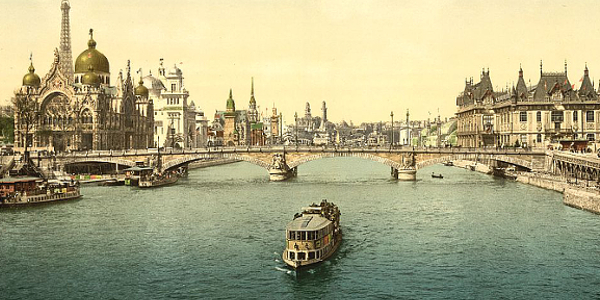
PARIS, FRANCE 1900
Exposition Universelle.
Sponsor this page. Your banner or text ad can fill the space above.
Click here to Sponsor the page and how to reserve your ad.
Quick List Info
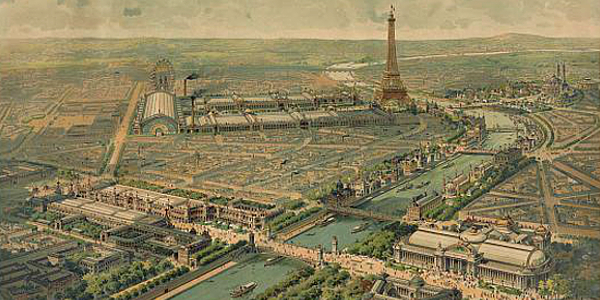
Dates Open - April 15 to November 12, 1900. Open 212 days, Open Sundays. Official inauguration April 14.
Attendance - 39,027,177 entries paid; , Total Visitors 50,860,801, including auxiliary site at Vincennes. Total visitors also included staff.
International Participants - 42 nations and 25 colonies.
Total Cost - 119,225,707 francs ($18,746,186). Expenses were covered by France and the City of Paris.
Site Acreage - Main site 267 acres, Vincennes annex 276 acres (Olympics held there plus other exhibits) . Total acreage 543.
Sanction and Type - Prior to the Bureau of International
Exhibitions. Paris 1900 would be considered a Universal scale registered event today.
Ticket Cost - Adult Admission Price, NA. Two to five tickets required some days.
Photo top center: Pavilions of the Nations and bridges, Italian Pavilion on the left, at the Paris Universelle Exposition Internationale, Detroit Publishing Company, 1900. Courtesy Wikipedia Commons. Column Top: Image of a panaramic view of Paris 1900 exposition, Lucien Baviac, 1900. Courtesy Library of Congress.

Minute Walk in History
Paris 1900
It was a world's fair, or international expo, that was meant to define the end of a century and the beginning of the next. Take a stroll back to the year 1900 past an Eiffel Tower plus the exhibiting nations, and their colonies, who showed their technology and wares on both sides of the Seine. And there was an Olympic Games held along with it, too. With video from Thomas Edison.
Other Histories of World's Fairs to Check Out
-
Quick List of All Expos
1st World's Fair in History
London 1851
Other Paris Fairs
Paris 1855
Paris 1867
Paris 1878
Paris 1889
Paris 1900
Paris 1925
Paris 1931
Paris 1937
- For more info about the World's Fair Decision Model, development of the model, the study participants, etc. The development is currently being utilized for in-house publishing projects, but is not available for work-for-hire decuments or consulting.
- For More info about the Bureau of International Exhibitions - Sanctioning body for international exposition (world's fairs) headquartered in Paris, France.
- For more info about previous EXPOcheck reports.
History of the Event
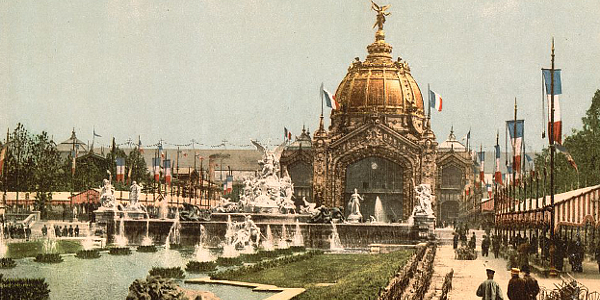
The fifth Universelle Exposition held in Paris, with planning starting in 1892 to celebrate the 19th century. Paris chose the date fueled by rumors that Kaiser Wilhelm and Berlin were planning a fair for 1900, and the rivalry in all matters, both diplomatic, militarily, and in such things as fairs had been raging between the two nations for years and would continue through World War II when the fair site was overtaken by German tanks. The Germans did come and exhibit. It was held on the traditional site, with expanded acreage on both sides of the Seine, plus an additional annex location in Vincennes where the twinned Olympic Games were held. Yes, the Olympic Games were held as a second cousin to a World's Fair, something today we would not think possible. It was larger than the past Paris fairs, including one hundred and eleven covered acres in exhibit buildings and eighty-three thousand exhibitors.
New buildings were built and the Trocadero Palace as well as the Eiffel Tower remained as structures on the grounds. There was controversy over the placement of the United States, which originally was not put in a position as a world power; in the end, it was squeezed between Austria and Turkey.
Overall, the buildings, built in two styles, traditionalist and Art Nouveau, were sometimes criticized. One hundred and seventy-five pavilions and thirty-six national pavilions were located in a double row of the Quai d' Orsay. There were significant firsts shown at the fair, including the display of x-ray machines, of wireless telegraphy, of automated food service and sound-synchronized movies. There was a large area for automotive exhibits and a section devoted to flying machines.
Above photo. Another view of the Paris 1900 exposition, 1900. Below: View of the Tracadero at the 1900 fair, built for the 1878 universelle exposition. Photos courtesy Library of Congress.
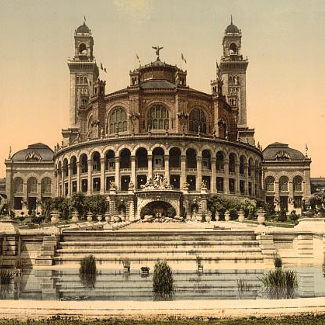
Electricity provided much interest and invention. The program of light and water on Chateau d'Eau drew crowds every night. The modern Olympic Games came to the Vincennes annex; the first time a city outside Greece hosted them.
The exposition lost money and fell short of the overestimated prediction of one hundred million attendance. That didn't please some concessionaires, athough it was odd that such a prediction was made in the first place, as no fair had come close to that figure in the past and still has not. There were high organizational and running costs. It was estimated to cost a visitor six hundred francs to see all commercial attractions. Rents to lease were very high. Many concessionaires had financial difficulties, threatened to strike, and eventually received a partial refund on rents. The public was said to be disappointed overall, thinking after the fair had closed that the future of France did not see themselves as hosting additional fairs as its power on the world stage waned.
Historian Perspective
Aram Yengoyan - "Paris, much of the Press after its closure attacked the fair and the idea of the fair. This came from the right and the left in France, and many in the Press felt that it should never be done, one reason is that the invited nations for a variety of different reasons made France and the French look mildly inadequate at best. Both Paris and St. Louis (1904) expressed the colonial system, the St. Louis fair had a lot in regards to the colonial possessions and also the ability to Americanize the world. Paris played the glory of France/French culture in terms of globalization."

Fifth Paris Expo
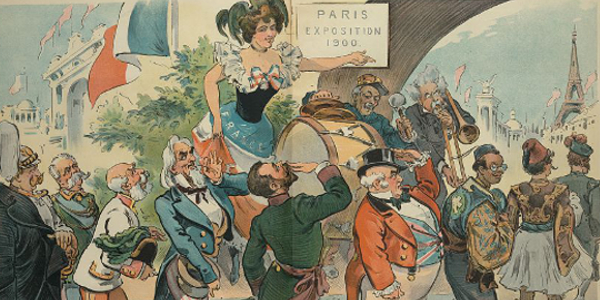
International Participants
Nations and Colonies
Nations - Germany, Andorra, Austria, Belgium, Bosnia-Herc., Bulgaria, Denmark, Spain, Great Britain, Greece, Hungary, Italy, Luxembourg, Monaco, Norway, Netherlands, Portugal, Romania, Russia, San Marino, Serbia, Sweden, Switzerland, Turkey, Liberia, Morocco, Republic of South Africa, Orange Free State, United States, Ecuador, Guatemala, Mexico, Nicaragua, Peru, Salvador, China, Korea, Japan, Persia, Siam, France.
Accepted but did not come - Bolivia, Costa-Rica, Domincan Republic.
French Colonies/Protectorates - Algeria, French Congo, Ivory Coast, Dahomey, Guadeloupe, French Guiana, Guyana, French India, Indochina (Cambodia/Tonkin), Madagascar, Martinique, Mayotte et les Comores, New Caledonia, French Oceania, Reunion, St. Peter and Michael, Senegal, French Somalia, Sudan, Tunisia.
Other Colonies - India (GR.-BRIT.), Canada (GR. BRIT.), Western Australia (GR. BRIT.), Other British Colonies, Dutch East Indies (COL-NETH.), Portugal colonial, Finland (RUSSIA).
Nations with National Pavilions - Germany, Austria, Belgium, Bosnia-Hercegovina, Bulgaria, China, Korea, Denmark, Ecuador, Spain, United States, Great Britain, including Palace of India and Palace of the Colonies, Greece, Guatemala, Hungary, Italy, Japan, Luxembourg, Morocco, Mexico and Salvador, Monaco, Nicaragua, Norway, Netherlands, including Dutch Indies and Western Sumatra, Peru, Persia, Portugal, including colonial pavilion, Romania, Russia, including Finland, San Marino, Serbia, Siam, South Africa, including Transvaal, Sweden, Switzerland, Turkey.
Expo Tidbits
Sousa Band represented the United States on July 4 for the unveiling of the statue of Lafayette presented to the French on behalf of the children of the USA. He wrote "Hail to the Spirit of Liberty."
Inside site, the Trottier Roulant, moving sidewalk at two speeds with a stationary third platform, cost 50 centimes, for route between Champ de Mars and Esplanade des Invalides. Receipts did not cover costs.
Electric train completed full circuit of expo site in 20 minutes.
652,082 attendance on October 7 was the highest of the fair.
Legacies
Three permanant structures were erected; the Grand Palais, the Petit Palais, which became the Paris Museum of Fine Arts, and the ornate Alexander III Bridge, which linked the Champs de Elysees with the Esplanade des Invalides.
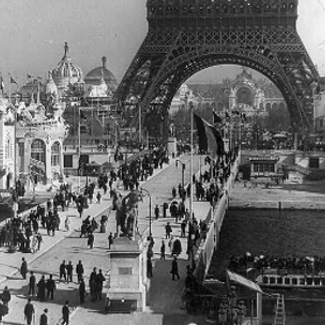
Those in Charge
Commissioner General was Alfred Picard.
Sources: World's Fair Magazine; Fair News; London Times; New York Times; Ephemeral Vistas; Historical Dictionary of World's Fairs by Alfred Heller; History of Fairs and Expositions; Worlds Fairs from 1851-1893; Les Fastes du Progres; "The World Exposition in Paris, 1900" by Ludger Derenthal and Andrea Lesjak; Bureau of International Exhibitions.
Photo column top: Political cartoon entitled Business Business showing Lady France at the Paris 1900 fair, holding court with foreign leaders from the United States, Great Britain, and others. Middle: The Eiffel Tower and the Champ de Mars at the Paris 1900 Universelle Exposition. Photos courtesy Library of Congress.
Accepted but did not come - Bolivia, Costa-Rica, Domincan Republic.
French Colonies/Protectorates - Algeria, French Congo, Ivory Coast, Dahomey, Guadeloupe, French Guiana, Guyana, French India, Indochina (Cambodia/Tonkin), Madagascar, Martinique, Mayotte et les Comores, New Caledonia, French Oceania, Reunion, St. Peter and Michael, Senegal, French Somalia, Sudan, Tunisia.
Other Colonies - India (GR.-BRIT.), Canada (GR. BRIT.), Western Australia (GR. BRIT.), Other British Colonies, Dutch East Indies (COL-NETH.), Portugal colonial, Finland (RUSSIA).
Nations with National Pavilions - Germany, Austria, Belgium, Bosnia-Hercegovina, Bulgaria, China, Korea, Denmark, Ecuador, Spain, United States, Great Britain, including Palace of India and Palace of the Colonies, Greece, Guatemala, Hungary, Italy, Japan, Luxembourg, Morocco, Mexico and Salvador, Monaco, Nicaragua, Norway, Netherlands, including Dutch Indies and Western Sumatra, Peru, Persia, Portugal, including colonial pavilion, Romania, Russia, including Finland, San Marino, Serbia, Siam, South Africa, including Transvaal, Sweden, Switzerland, Turkey.
Sousa Band represented the United States on July 4 for the unveiling of the statue of Lafayette presented to the French on behalf of the children of the USA. He wrote "Hail to the Spirit of Liberty."
Inside site, the Trottier Roulant, moving sidewalk at two speeds with a stationary third platform, cost 50 centimes, for route between Champ de Mars and Esplanade des Invalides. Receipts did not cover costs.
Electric train completed full circuit of expo site in 20 minutes.
652,082 attendance on October 7 was the highest of the fair.
Three permanant structures were erected; the Grand Palais, the Petit Palais, which became the Paris Museum of Fine Arts, and the ornate Alexander III Bridge, which linked the Champs de Elysees with the Esplanade des Invalides.

Sources: World's Fair Magazine; Fair News; London Times; New York Times; Ephemeral Vistas; Historical Dictionary of World's Fairs by Alfred Heller; History of Fairs and Expositions; Worlds Fairs from 1851-1893; Les Fastes du Progres; "The World Exposition in Paris, 1900" by Ludger Derenthal and Andrea Lesjak; Bureau of International Exhibitions.
Photo column top: Political cartoon entitled Business Business showing Lady France at the Paris 1900 fair, holding court with foreign leaders from the United States, Great Britain, and others. Middle: The Eiffel Tower and the Champ de Mars at the Paris 1900 Universelle Exposition. Photos courtesy Library of Congress.
History of America
Check out our partners at America's Best History for the history of the United States. Great for students of history or just those that want to find out a little more about the whats, when, wheres, and how of heritage tourism.

To the 1900s
Baseball Stat Books

-
Stat Geek Baseball, the Best Ever Book
Stat Geek Baseball, the Best Ever Book. Some of the most unique info on the Best Ever in baseball you'll get anywhere! The Best Yankee! The Best Red Sox! The Best of Every Team!
-

-
Fields of Gold, Baseball's Best Glove Work
The newest book in the Stat Geek Baseball universe. Fields of Gold, Baseball's Best Glove Work. It's what the Best Ever Book was for hitting and pitching, but now a detailed look at the Best Fielders in Baseball History, including best position players for every team, and best overall for every position
